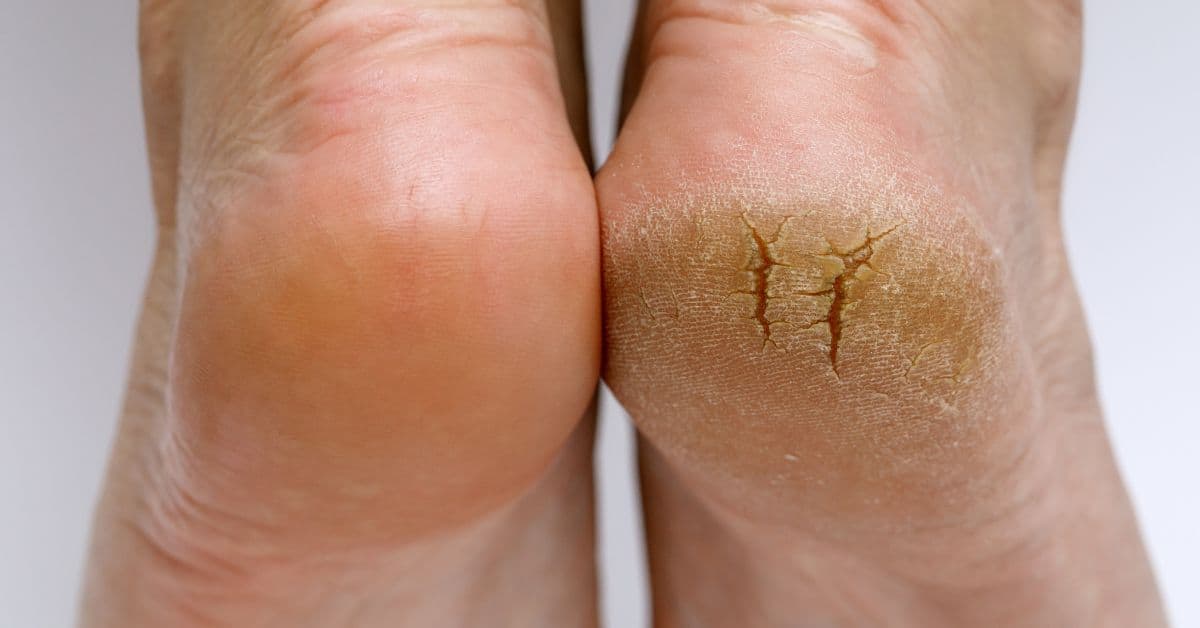If you’ve ever asked yourself, “What is a callus?” you’re not alone. Calluses are common, hardened patches of skin that develop due to repeated friction, pressure, or irritation. While they are your body’s way of protecting sensitive skin from injury, calluses can sometimes cause discomfort or lead to complications if left untreated. Understanding what a callus is, how to treat it, and how to prevent it is key to maintaining healthy and pain-free feet.
This comprehensive guide will cover everything you need to know about calluses, including their causes, symptoms, treatment options, and prevention strategies. Whether you’ve been dealing with a callus for years or are noticing one for the first time, our podiatrists can help.
What is a Callus?
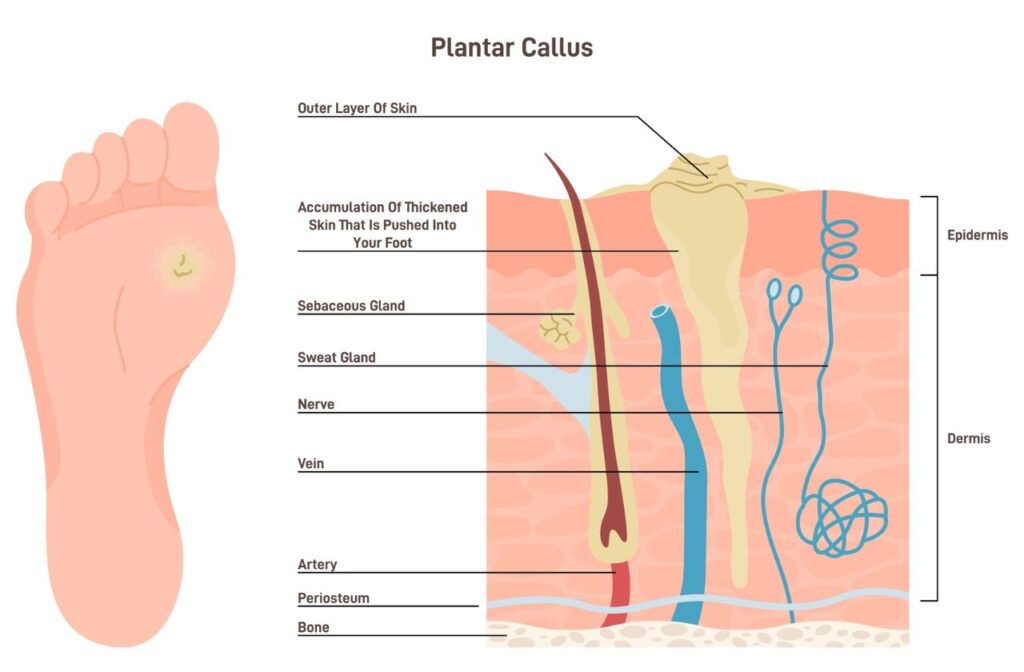
Calluses develop as a result of your skin thickening to protect itself from excessive friction or pressure. They can occur anywhere on the body but are most common on the feet and hands as they are the most prone to repetitive friction. Skin cells become over-productive in the area causing a rapid build up of hard, dry skin.
Callus is drier and less elastic than regular skin, which means that it will often crack leading to painful splits in the skin.
What Causes a Callus?
Callus is primarily caused by friction and pressure to the skin of the feet and hands, however there are a number of factors which can make you more prone to callus.Below are some common causes of calluses:
1. Poorly Fitting Footwear
Shoes that are too tight, loose, or poorly designed can create pressure points on your feet. For example:
- Tight shoes squeeze your toes, leading to friction.
- Loose shoes allow your feet to slide, causing rubbing.
- High heels force weight onto the balls of your feet, increasing pressure.
- Barefoot or thin shoes increase the pressure on the heels and balls of you feet. Your feet are also more exposed to the elements e.g. wind, moisture and rough ground.
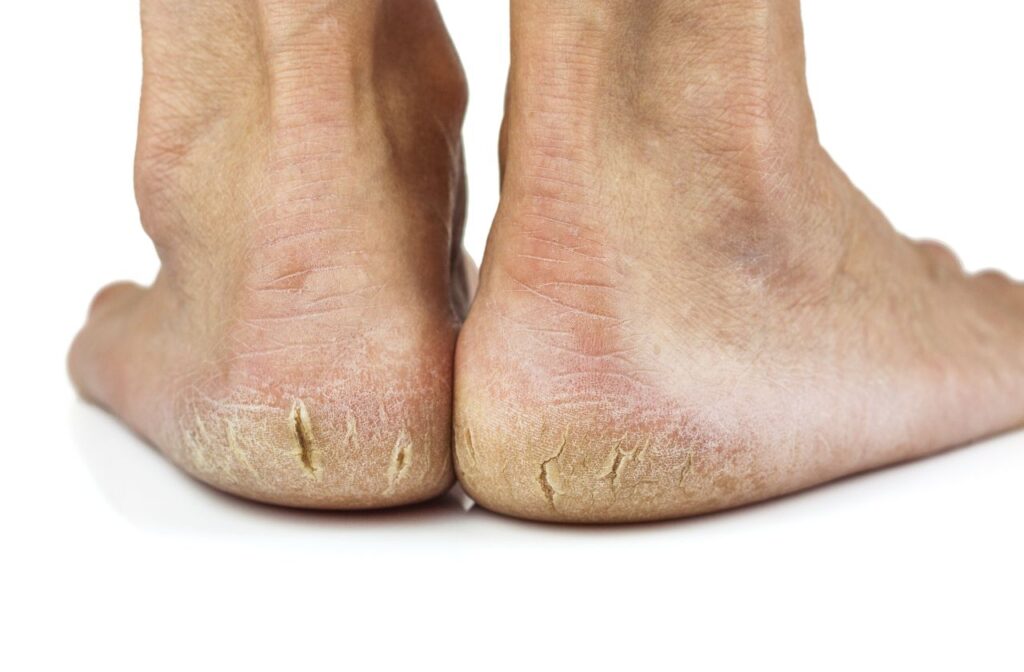
2. Repetitive Activities
Certain activities can put continuous pressure on specific areas of your feet or hands, such as:
- Running, jogging, or hiking.
- Sports like tennis, basketball, or dance.
- Using hand tools, gardening, or playing musical instruments.
3. Walking Barefoot
Walking barefoot on hard surfaces, like concrete or tiles, can cause your skin to thicken as a protective measure. If the surface is rough, the callus will form quicker as your body is quickly produces callus as a response to micro-tears in the skin.
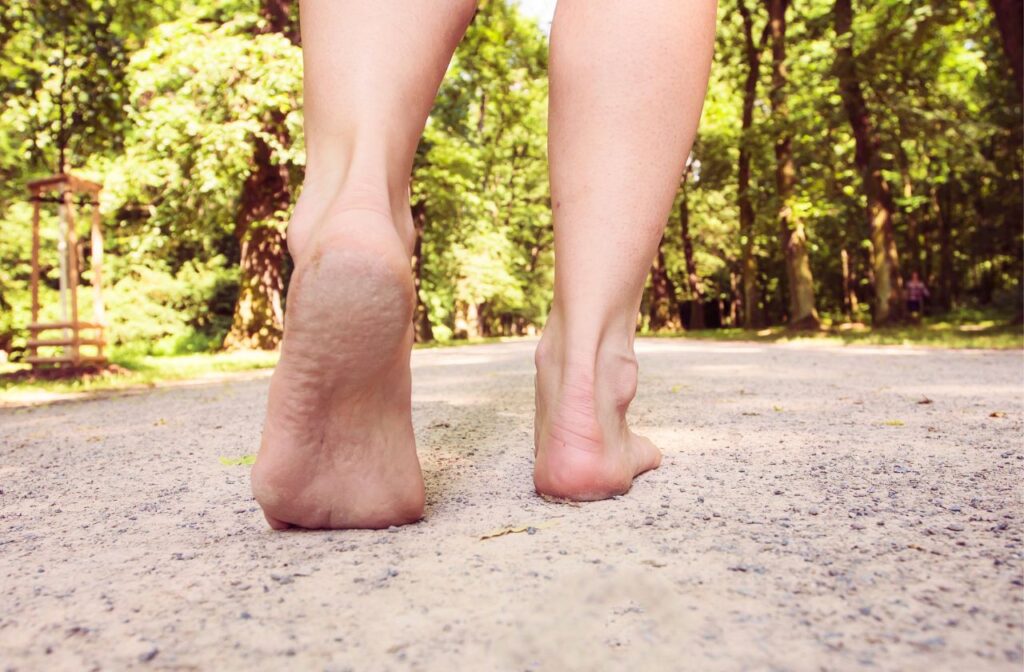
4. Biomechanical Factors
Foot deformities or irregular gait patterns can increase pressure on specific parts of your feet. Examples include:
- Flat feet or high arches.
- Bunions, hammertoes, or heel spurs.
- Uneven weight distribution while walking or standing.
Recognising the cause of your callus is the first step in preventing it from recurring.
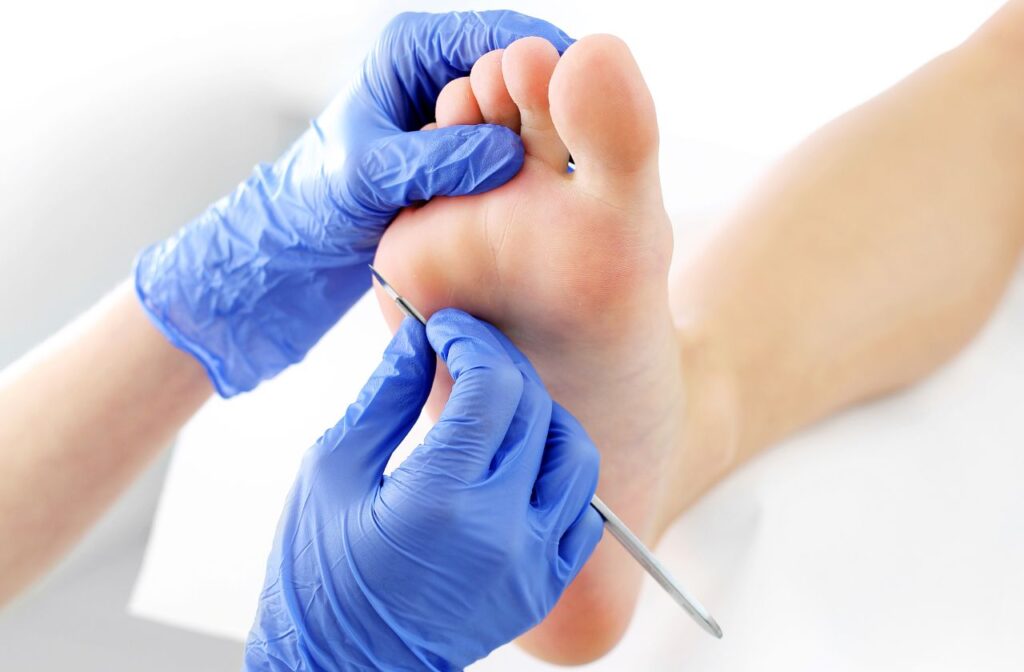
Symptoms of a Callus
You might be dealing with a callus if you notice the following signs:
- Hardened skin: A thickened, tough patch that may feel rough to the touch.
- Yellow or grey appearance: Calluses often appear discoloured compared to the surrounding skin.
- No sharp pain: Unlike corns, calluses are generally not painful unless they become cracked or infected.
- Flat and broad: Calluses tend to be wider and more spread out than corns.
Calluses can appear on various parts of your body, but they are most common on the heels, ball of your foot, and sides of your toes.
Calluses vs. Corns: What’s the Difference?
Although calluses and corns are often confused, they are distinct conditions:
Callus | Corn | |
Size and Shape | Larger, flat, and broad. Surrounding skin often inflamed or red. | Smaller, round, and raised. Surrounding skin is normal. |
Location | Areas of frequent friction e.g. heels, side of toes. | Bony areas like toes and under the ball of your foot. |
Feeling | Usually a dull ache or burning feeling. Very painful when cracked. | Often only painful with direct pressure. Feels like a ‘rock’ in foot. |
If you’re unsure whether you have a callus or a corn, consult a podiatrist for a professional diagnosis.
Effective Ways to Treat Calluses:
Treating calluses depends on their size, severity, and underlying cause. While some calluses can be managed with at-home remedies, others require professional care.
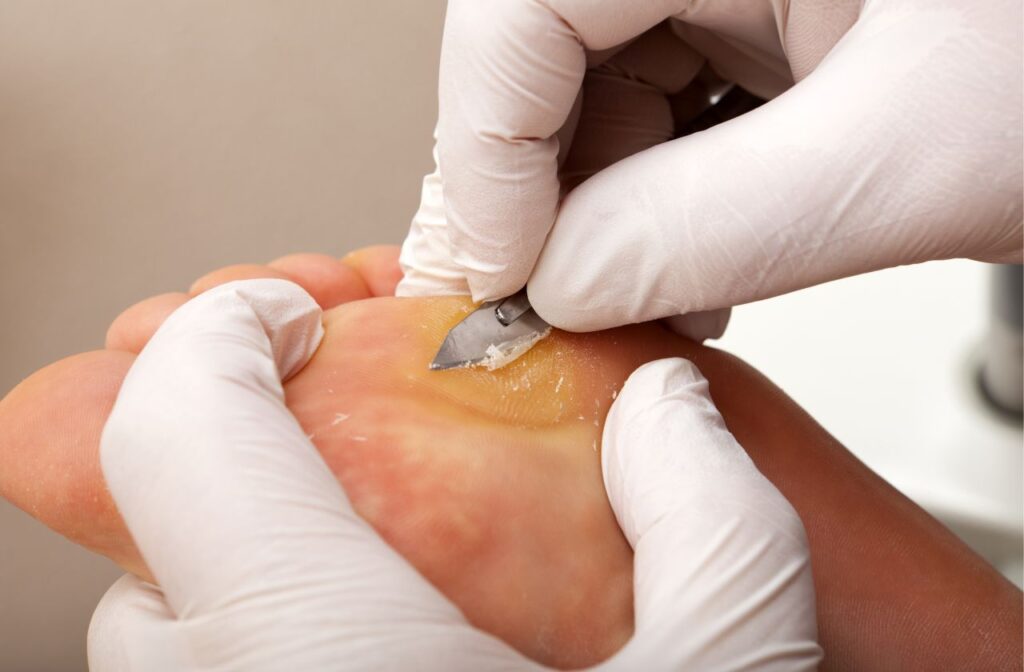
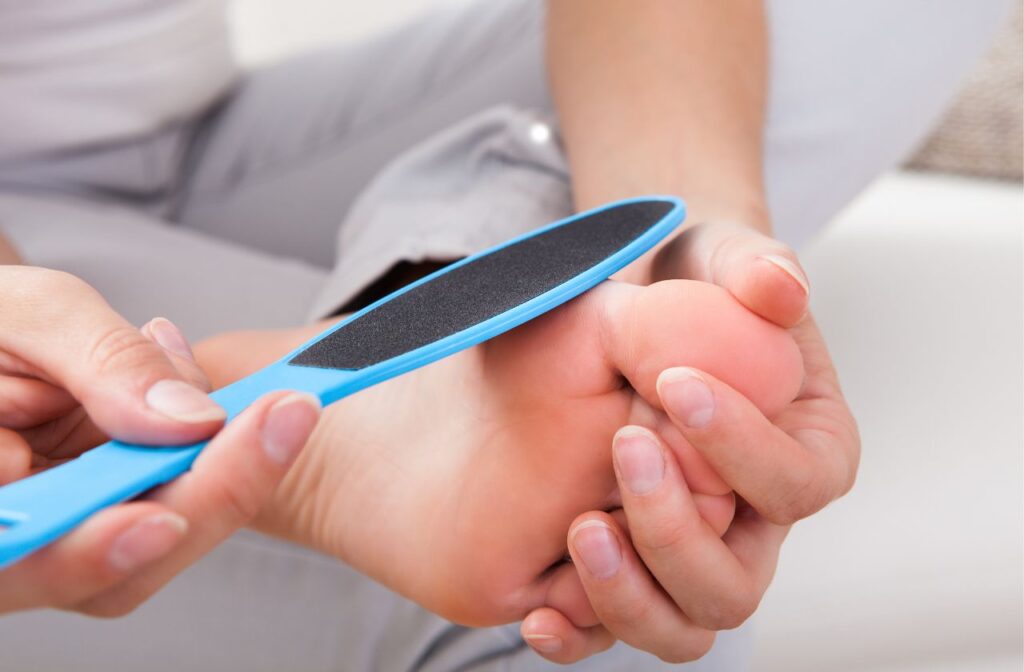
Home Treatment Options
- Soak and soften: Regularly soak your feet in warm, soapy water to soften the skin. Adding Epsom salts can enhance the effect.
- Exfoliate carefully: Use a pumice stone, emery board, or foot file to gently remove dead skin. Avoid being too aggressive, as this can lead to irritation.
- Moisturise daily: Apply a rich foot cream containing urea, lactic acid, or salicylic acid to keep the skin hydrated and prevent further thickening.
- Cushion and protect: Use non-medicated callus pads or gel cushions to relieve pressure.
See a Podiatrist
You should seek professional care if:
- The callus becomes painful, red, or swollen.
- You have diabetes or circulation problems, as these conditions increase the risk of complications.
- The callus recurs frequently despite home treatment.
- There are cracks in the callus, which may allow bacteria to enter and cause infection.
A podiatrist may remove the callus using safe, sterile methods or recommend custom orthotics to address underlying biomechanical issues.
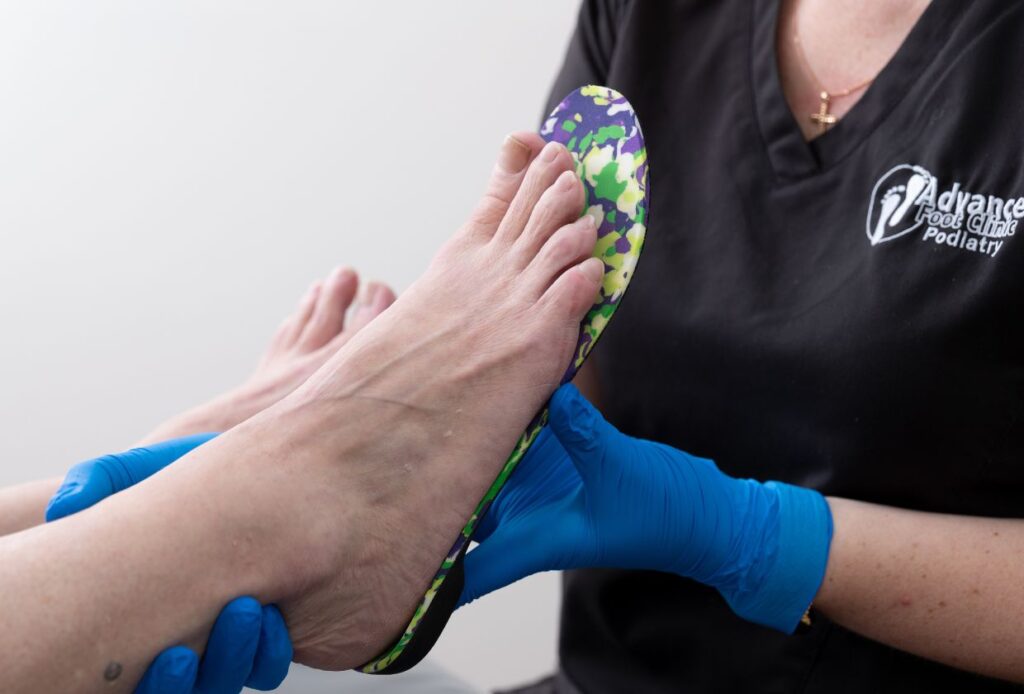
Prevention: How to Stop Calluses Before They Start
Preventing calluses is easier than treating them. By taking a few proactive steps, you can protect your skin from excessive friction and pressure.
1. Choose the Right Footwear
- Opt for shoes with a wide toe box to reduce pressure on your toes.
- Avoid wearing high heels for long periods.
- Replace worn-out shoes that no longer provide adequate support.
2. Use Protective Gear
- Cushion high-friction areas with gel pads or moleskin.
- Wear gloves when using hand tools or engaging in activities that cause hand friction.
3. Maintain Good Foot Care
- Keep your feet clean and dry to prevent skin problems.
- Trim your toenails straight across to avoid pressure on the toes.
- Moisturise regularly to prevent dryness and cracking.
4. Address Underlying Issues
If you have flat feet, high arches, or other structural problems, consider consulting a podiatrist. Custom orthotics can help redistribute weight and minimise pressure.
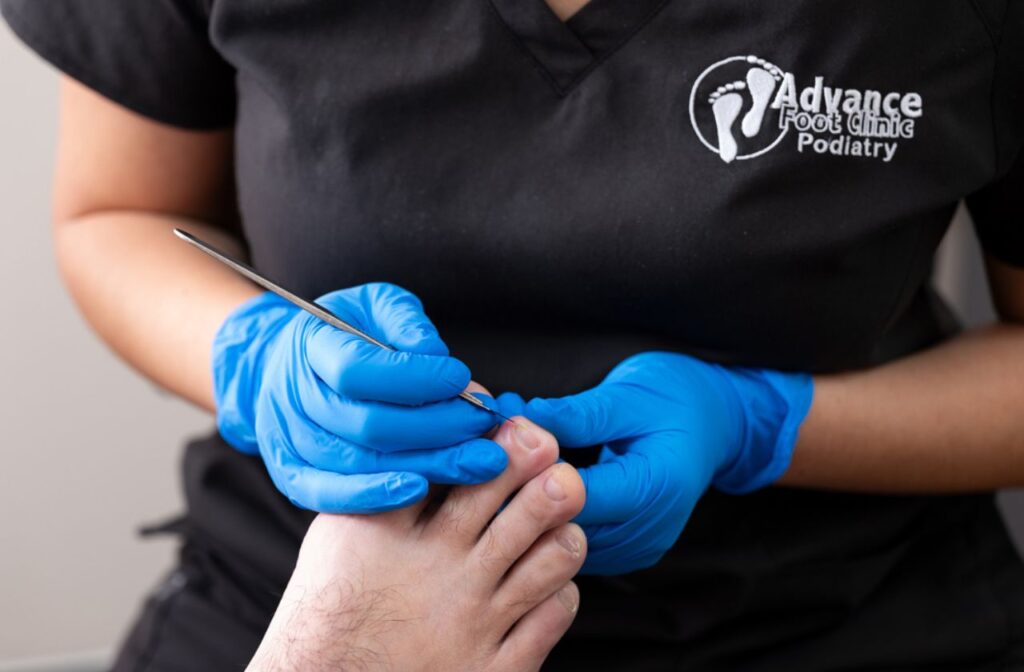
FAQs About Calluses
- Are calluses permanent?
Calluses are not permanent and can be managed or removed with proper care. However, they may return if the underlying cause isn’t addressed. - Can calluses lead to complications?
If left untreated, calluses can crack, leading to pain or infection. This is especially risky for people with diabetes or compromised circulation. - Are calluses preventable?
Yes, by wearing proper footwear, protecting high-friction areas, and maintaining good foot hygiene, you can significantly reduce your risk of developing calluses.
Why Choose Advance Foot Clinic Podiatry for Callus Care?
If calluses are causing discomfort or affecting your quality of life, professional care can make all the difference. Advance Foot Clinic Podiatry offers tailored treatment plans to address your unique needs. Our experienced team provides:
- Safe removal of calluses.
- Custom orthotics to correct foot mechanics.
- Expert advice on footwear and foot care.
With five convenient locations across Brisbane and Mount Isa, we’re here to help you maintain healthy, pain-free feet.


